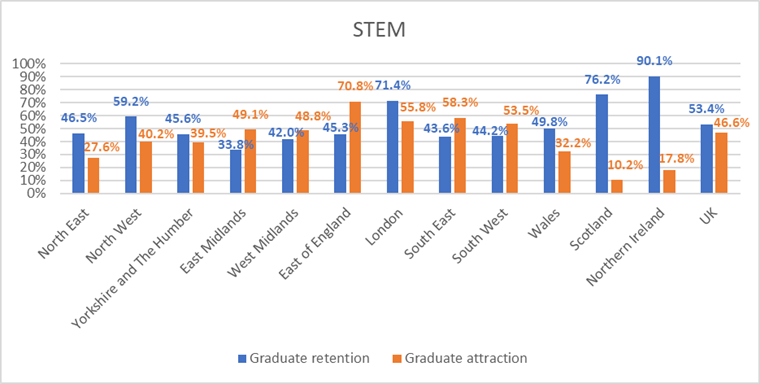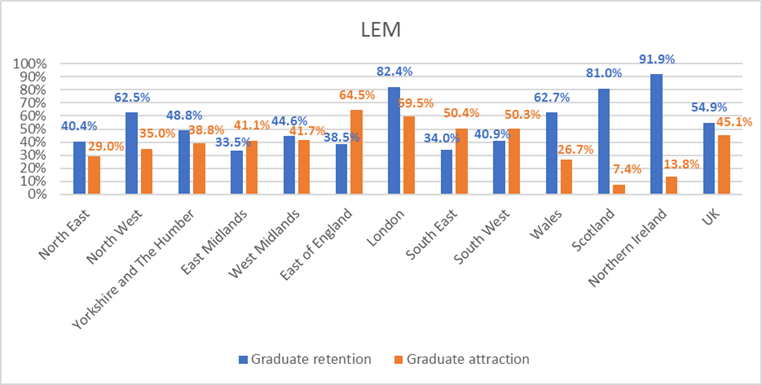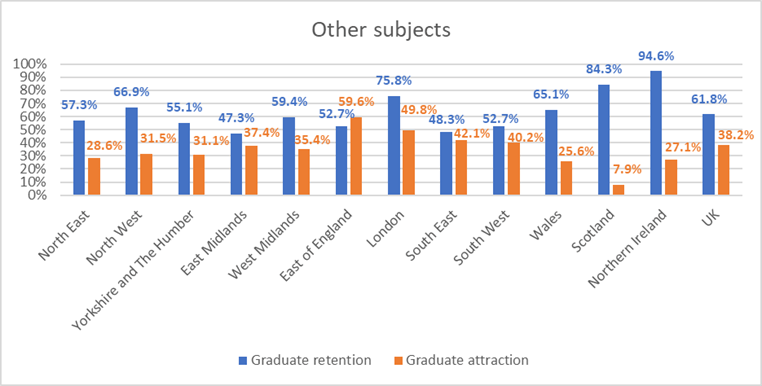Dr Kostas Kollydas explores the factors that influence the geographical mobility of UK graduates and the role innovation has in attracting and retaining talent in a region
It is widely acknowledged that the skill composition of a region's workforce plays a vital role in its economic performance. Higher education graduates represent a remarkably geographically mobile group of the labour force that can increase productivity and drive regional economic growth. This becomes particularly relevant in light of the notable disparities in productivity levels between the UK regions, with London experiencing by far the highest productivity in the country.1
Reducing economic inequalities between UK places is at the heart of the government's levelling up agenda.2 Moreover, the advent of new technologies in specific sectors, such as automation and artificial intelligence, has increased the demand for high-level skills. This is also partially connected with existing shortages of Science, Technology, Engineering and Mathematics (STEM) skills and the established skills mismatch issue in the UK labour market.3
Motivated by the increased policy interest in fostering economic and social reforms related to regional convergence and addressing the deficit of high-skilled workers at the national level, two recent reports by the West Midlands Regional Economic Development Institute (WMREDI) shed light on key factors that influence the geographical mobility decisions of university graduates.4 These reports draw on Graduate Outcomes survey data for the academic year 2018/19 to calculate the retention and attraction rates for the nine English regions, Wales, Scotland and Northern Ireland, for graduates in employment 15 months after finishing their course.5
Regional graduate retention/attraction patterns
While most higher education graduates work in their region of study 15 months after completing their studies (UK average retention rate: 58.1%), the WMREDI research reveals remarkable regional differences in the attraction and retention rates. For instance, there is a clear North-South divide in the graduate attraction figures. Specifically, of the total 2018/19 university graduates who relocated to a different region for work, 65.3% moved to London, the East of England, the South East and the South West, whereas only 15.9% migrated to the northern English regions.
As the figure below illustrates, the regional mobility behaviour of graduates varies by the area of subject studied. Graduates with a qualification in Arts, Humanities, and Education are far more likely than STEM and LEM (Law, Economics and Management) graduates to stay in their region of study for work. Conversely, regional attraction rates are generally higher among STEM graduates than those with degrees in other subject areas.
Graduate attraction and retention rates by region and subject area of study



Moreover, the likelihood of 'staying local' is more pronounced for new graduate workers who attended a postgraduate taught course (standing at 63.4% on average in the UK) than those who hold only a first degree (54.4%). This implies that students make rational decisions regarding the region of their postgraduate studies, which, in many cases, is inextricably linked with their subsequent employment destination and career goals.
When it comes to the type of university, the attraction rates are more prominent among the Russell Group university graduates relative to their counterparts who earned a degree from other institutions (UK average: 50.1% versus 38.8%). A possible explanation is that students attending elite universities may apply to more opportunities, and receive more offers for work, from across the UK regions and nations. It is likely that employers perceive a degree from a well-regarded university as a signalling tool of graduates' quality and skills, particularly at the beginning of their careers. In addition, selective institutions could have more strategies in place that improve their students' productivity through collaborations with partner businesses. Moreover, Russell Group university students may have more geographically extensive social networks, which help link them to employment opportunities.
Finally, it is not surprising that 76.3% of university graduates are employed in high-skilled occupations (managerial and professional jobs) 15 months after completing higher education. New workers holding these positions are less likely than others to be employed in their region of study, suggesting that such graduates are sufficiently flexible in pursuing career opportunities in other regions.
The role of innovation in attracting/retaining graduates
Policies aiming to create new high-skilled jobs are crucial for attracting and retaining talent to a region. To put this in context, boosting innovation and research and development (R&D) investments should benefit the UK regions. R&D is a critical driver of economic growth, as it can augment the average gross value added (GVA) per capita.6 However, there are dramatic regional imbalances in the distribution of R&D investments.7
The UK government recently announced its target to raise the annual public R&D spending to £22billion by 2027, thus aiming to increase the total R&D expenditure (public and private) to 2.4% of the GDP in that year.8 If this increase in R&D expenditure is accompanied by an equitable distribution nationally, it should create opportunities for the further development of specific sectors and enhance the demand for specific skills (such as STEM-related capabilities) across the UK, particularly in 'left-behind' areas. Therefore, supporting regional economic growth through innovation would likely contribute to attracting more graduates to an area, thus improving its overall competitiveness.
You can find out more about this research here.
Notes:
- Regional labour productivity, including industry by region, UK: 2019, ONS, 2021.
- Devolution and Levelling Up: Boon or Bane for the Region?, University of Birmingham, 2021.
- Industrial Strategy: Building a Britain fit for the future, HM Government, 2017.
- Graduate Attraction and Retention at Regional Scale, University of Birmingham.
- Definitions: Graduate Outcomes, HESA.
- Levelling Up Through Innovation, University of Birmingham, 2021.
- The Missing £4 Billion: Making R&D work for the whole UK, Nesta, 2020.
- Autumn Budget and Spending Review 2021, HM Treasury, 2021.
Note on graphs: STEM (Science, Technology, Engineering, and Mathematics) subjects include 'Physical sciences', 'Mathematical sciences', 'Computer science', 'Biological sciences', 'Veterinary science', Engineering & technology', 'Agriculture & related subjects', and 'Architecture, building & planning'. LEM (Law, Economics and Management) subjects refer to 'Law', 'Business & administrative studies', and 'Social studies'. Other subjects include 'Mass communications & documentation', 'Languages', 'Historical & philosophical studies', 'Creative arts & design', and 'Education'.
'Graduate retention' is defined as the proportion of new graduate workers employed in the region where they studied over the total number of new graduate workers that studied in that region. 'Graduate attraction' represents the number of new graduate workers that come from other UK regions of study relative to the total number of new graduates employed in the destination region.
Source: WMREDI report on 'Regional brain drain and gain in the UK: Regional patterns of graduate retention and attraction' using the Graduate Outcomes Survey data from HESA, 2018/19.
Was this page useful?
Thank you for your feedback
